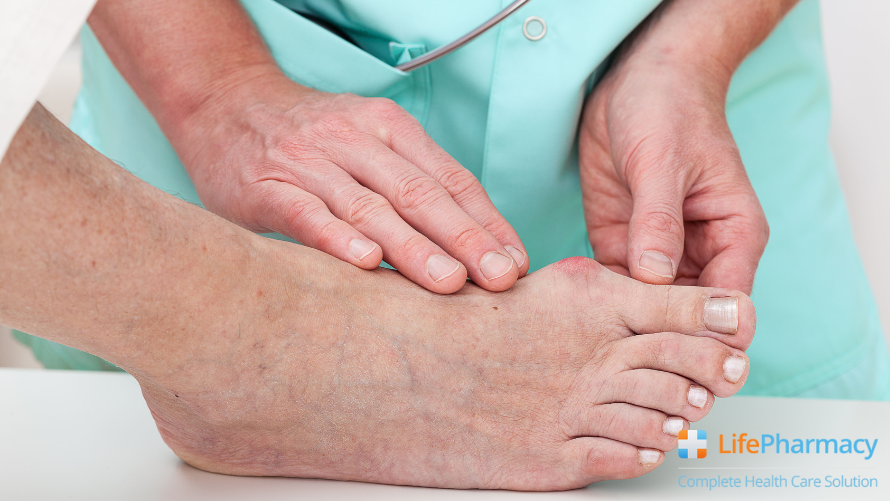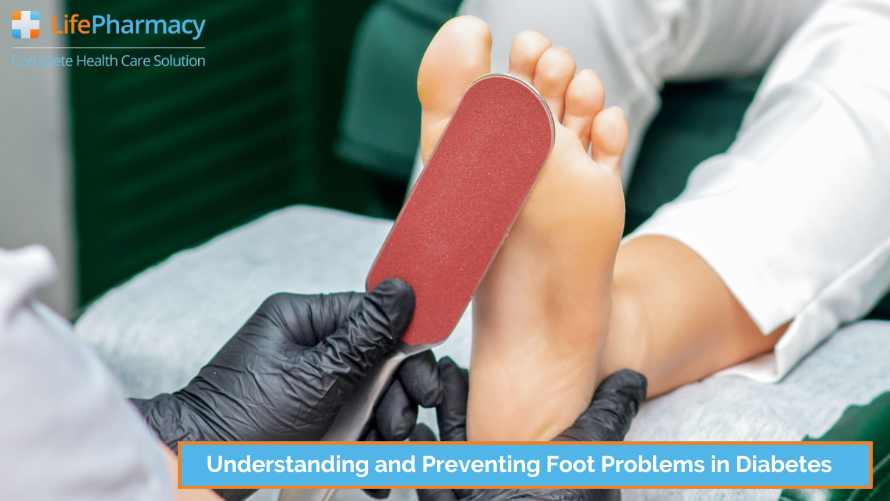Online chemists have curated this blog to help you understand and prevent foot problems in diabetes:
There are two primary problems that diabetes can cause in relation to your feet:

-
Peripheral vascular disease
This is a consequence of diabetes, which affects blood flow throughout your body. Insufficient blood flow slows down the healing process for sores or cuts. This condition, known as peripheral vascular disease, can lead to the formation of ulcers or even gangrene if an infection persists due to inadequate blood circulation. Infections and gangrene can be limb-threatening or life-threatening when they occur in conjunction with a foot ulcer.
-
Diabetic neuropathy
It occurs when uncontrolled diabetes damages the nerves in your legs and feet. Did you know that around half of all individuals with diabetes experience some form of nerve damage? While this damage can affect any part of your body, it commonly targets the nerves in your feet and legs. As a result, you may lose sensation in your feet.
Nerve damage can present itself in various forms, such as numbness, tingling, or even pain. Surprisingly, some individuals with neuropathy may not experience any symptoms at all. However, this lack of sensation poses a problem as it impairs the ability to recognize potential issues like pain, heat, or cold. Additionally, nerve damage can affect the muscles controlling foot movement, causing misalignment and excessive pressure on specific regions.
Although pain relief may seem appealing, it carries significant consequences. Pain serves as a vital alarm system, signaling the body to address potential problems promptly. Without the ability to perceive foot pain, one may inadvertently overlook cuts, blisters, sores, or other issues. Even minor concerns can rapidly escalate into severe complications if not given immediate attention.
Factors That Increase The Risk Of Nerve Damage in Diabetes
Nerve damage is a common complication of diabetes, but certain factors can increase your risk. If you experience any of the following, it's important to be vigilant:
-
Difficulty managing blood sugar levels: Uncontrolled blood sugar can contribute to nerve damage.
-
Long-standing diabetes with consistently high blood sugar: Prolonged exposure to elevated levels increases the likelihood of nerve damage.
-
Being overweight: Excess weight can strain your body's ability to manage blood sugar effectively.
-
Age over 40: Nerve damage becomes more prevalent as we get older.
- High blood pressure and cholesterol: These conditions can further impair nerve function.
Are your diabetes and blood pressure constantly fluctuating?
Call your trusted healthcare provider Life Pharmacy UK and book your diabetes and blood pressure monitoring devices right away.
Don't let your health wait any longer!
Diabetic Foot Symptoms
If you experience any of these symptoms, it is important to seek medical attention promptly. Contact your regular doctor or a foot specialist (podiatrist) for evaluation or it might lead to further complications.
-
Changes in skin color or temperature
-
Swelling in the foot or ankle
-
Pain in the legs
-
Slow-healing or draining open sores on the feet
-
Ingrown toenails or toenail fungus
-
Corns or calluses
-
Dry, cracked skin, especially around the heel
-
Unusual or persistent foot odor
-
Pain or cramping in the legs during physical activity
-
Tingling, burning, or pain in the feet
-
Loss of sensation or ability to feel temperature changes
-
Change in the shape of the feet over time
-
Hair loss on the toes, feet, or lower legs
-
Thickened, yellow toenails
-
Fungal infections such as athlete's foot
-
Blisters, sores, ulcers, infected corns, or ingrown toenails
Fungal infections can present itself in different ways on the skin, which makes it important to understand the symptoms and how to prevent them.
Complications of Diabetic Foot Problems
Ignoring the warning signs and failing to address foot problems in diabetes patients can lead to several complications. Here are some of the potential complications that can arise from negligence or delayed medical intervention:
-
Skin and bone infections: Even a small cut or wound can easily lead to infections due to nerve and blood vessel damage, along with immune system issues. Prompt treatment with antibiotics is crucial, and in severe cases, hospitalization may be necessary.
-
Abscess: Infections can sometimes eat into bones or tissue, forming a pocket of pus called an abscess. While draining the abscess is a common treatment, newer methods like oxygen therapy offer less invasive options, potentially avoiding the need for bone or tissue removal.
-
Deformities: Nerve damage can weaken the foot muscles, leading to conditions such as hammertoes, claw feet, prominent metatarsal heads (ends of the bones below the toes), or pes cavus, a high arch that doesn't flatten when weight is applied.
-
Charcot foot: The weakening of bones in the foot due to diabetes can make them susceptible to fractures. Nerve damage can prevent you from realizing the injury, causing you to continue walking on broken bones and resulting in a change in foot shape resembling a collapsed arch.
- Amputation: Poor blood flow and reduced sensation increase the risk of foot injuries going unnoticed until infections develop. When infections cannot be effectively treated, result in abscesses, or when gangrene develops due to limited blood flow, amputation may be the necessary course of action.
Foot Care Tips for Diabetics

To avoid any of the above mentioned foot problems, diabetics must take proper care of their feet. A few foot care tips from UK online pharmacy are as follows:
-
Take care of your overall health: Follow your doctor's advice on nutrition, exercise, and medication to manage your diabetes effectively and keep your blood sugar levels within the recommended range. Pharmacy online will provide all your prescribed meds right till your doorstep.
-
Daily foot inspection: Check your feet every day for any signs of sores, blisters, redness, calluses, or other problems. If you have poor blood flow, it's crucial to examine your feet daily.
-
Proper foot hygiene: Wash your feet daily in warm water using a mild soap. Test the water temperature with your elbow to prevent burns. Dry your feet thoroughly, especially between the toes.
-
Moisturize your feet: Apply lotion or moisturizer to keep the skin on your feet hydrated, but avoid applying it between the toes as it can lead to moisture buildup and potential infection. Consult your doctor for the best type of lotion to use. Besides your feet you can use a range of our skin care products to keep your skin radiant and hydrated.
-
Care for corns and calluses: Use an emery board or pumice stone to gently smooth corns and calluses after bathing when the skin is soft.
-
Proper toenail care: Trim your toenails straight across, and use a nail file to smooth any sharp edges. Avoid cutting the corners or sides of the nails. File in one direction only to avoid skin damage.
-
Wear appropriate footwear: Always wear closed-toed shoes or slippers to protect your feet. Avoid walking barefoot or wearing sandals. Choose shoes made of canvas or leather and break them in gradually. If you have foot deformities, consider using extra wide shoes.
-
Wear comfortable socks: Opt for well-fitting socks or stockings with soft elastic that provide cushioning and support for your feet. Seamless socks are preferable to minimize friction.
-
Inspect shoes before wearing: Check the inside of your shoes to ensure no objects are left inside that could cause discomfort or injury to your feet.
-
Protect your feet from extreme temperatures: Avoid exposing your feet to excessive heat or cold. Wear shoes at the beach or on hot pavement and wear socks to keep your feet warm at night if needed.
-
Promote good blood circulation: Elevate your feet when sitting, regularly wiggle your toes and move your ankles to improve blood flow. Avoid crossing your legs for extended periods. Quit smoking as it can worsen blood flow problems.
- Seek medical attention: Contact your doctor if you notice any worsening foot problems or if sores don't heal. Schedule a thorough foot exam with a podiatrist at least once a year.
Conclusion
So, don't underestimate the importance of foot care. The most effective approach to prevent foot problems and prevent minor issues from escalating into serious complications involves consistent self-care at home, obtaining necessary medications from the Life Pharmacy UK, and ensuring regular attendance to all medical appointments. By being proactive and attentive, you can prevent small issues from turning into significant setbacks.
Your feet deserve the care and attention that will keep you standing confidently on your own two feet!






